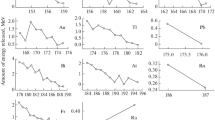Abstract
Rutherfordium is the synthetic and unstable element. It undergoes different radioactive decays such as alpha decay, beta decay, proton decay and spontaneous fission. In the present work, we have studied the competition between different decay modes such as alpha decay, beta decay, cluster decay, proton decay and spontaneous fission of Rutherfordium. By studying the competition between different decay modes, we have identified the dominant decay modes for different isotopes of mass number range 238 < A < 340. The variation of half-lives with mass number corresponds different decay modes are graphically represented. The energy released during different decay modes is also represented as a function of mass number. The calculated half-lives are compared with that of the other models available in the literature. To validate the present work, we have also compared values produced by the present method with that of the experiments.



Similar content being viewed by others
References
Barber RC, Greenwood NN, Hrynkiewicz AZ, Jeannin YP, Lefort M et al (1992) Discovery of transfermium elements. Prog Part Nucl Phys 29:453
Blocki J et al (1977) Proximity forces. Ann Phys 105:427–462
Budaca AI, Budaca R et al (2016) Extended systematics of alpha decay half-lives for exotic superheavy nuclei. Nucl Phys A 951:60–74
Condon U, Gurney RW (1928) Wave mechanics and radioactive disintegration. Nature 122:439
Gamow G (1928) Zur Quantentheorie des Atomkernes. Z Phys 51:204–212
Geiger H, Nuttall JM (1911) Ranges of particles from radioactive substances. Phylos Mag 22:613
Manjunatha HC (2016a) Theoretical prediction of probable isotopes of superheavy nuclei of Z = 122. Int J Mod Phys E 25(11):1650100
Manjunatha HC (2016b) Comparison of alpha decay with fission for isotopes of superheavy nuclei Z = 124. Int J Mod Phys E 25(9):1650074
Manjunatha HC (2016c) Alpha decay properties of superheavy nuclei Z = 126. Nucl Phys A 945:42–57
Manjunatha HC (2018a) Parameterization of fission barrier heights of medium, heavy and super heavy nuclei. Ind J Phys 92(4):507–512
Manjunatha HC (2018b) Fusion barrier characteristics of actinides. Nucl Phys A 971:83–94
Manjunatha HC, Sowmya N (2018) Competition between spontaneous fission ternary fission cluster decay and alpha decay in the super heavy nuclei of Z = 126. Nucl Phys A 969:68–82
Manjunatha HC, Sridhar KN (2017a) Survival and compound nucleus probability of super heavy element Z = 117. Eur Phys J A 53:97
Manjunatha HC, Sridhar KN (2017b) A probability of synthesis of the superheavy element Z = 124. Eur Phys J 53:196
Manjunatha HC, Sridhar KN (2017c) Projectile target combination to synthesis superheavy nuclei Z = 126. Nucl Phys A 962:7
Manjunatha HC, Sridhar KN (2018) Investigation to synthesis more isotopes of superheavy nuclei Z = 118. Nucl Phys A 975:136–153
Manjunatha HC, Seenappa L, Sridhar KN (2019) Uncertainties in the empirical formulae for alpha decay half-lives of heavy and superheavy nuclei. Eur Phys J 134:477
Möller P et al (2016) Nuclear ground-state and deformations. At Data Nucl Data Tables 109:1–204
Myers WD, Swiatecki WJ (2000) Nucleus-nucleus proximity potential and superheavy nuclei. Phys Rev C 62:044610
Ni D, Ren Z (2012) New formula of Half-lives for proton emission from spherical and deformed nuclei. Rom J Phys 57:407
Pansaers JK (1896) Paris 122, 420, 1896; Pansaers. J. K. Paris 122:521
Qiang SZ et al (2014) Competition between α-decay and β-decay for heavy and superheavy nuclei. Chin Phys C 38:12
Ren Z, Xu C (2005) Spontaneous fission half-lives of heavy nuclei in ground state and in isomeric state. Nucl Phys A 759:64–78
Sandulescu A, Poenaru DN, Greiner W (1980) New type of decay of heavy nuclei intermediate between fission and. cap alpha. decay. Sov J Part Nucl 11:528
Santhosh KP, Biju RK et al (2008) A semi-empirical model for alpha and cluster radioactivity. G Nucl Part Phys 35:085102
Sheng Zongqiang, Ni Dongdong et al (2011) Systematic calculations on cluster radioactivity half-lives. J Phys G: Nucl Part Phys 38:055103
Zhang YL, Wang YZ (2017) Systematic study on the competition between α-decay and spontaneous fission of superheavy nuclei. Nucl Phys A 966:102–112
Zhang XP et al (2007) Systematics of β− decay half-lives of nuclei far from the β-stable line. J Phys G: Nucl Part Phys 34:2611
Author information
Authors and Affiliations
Corresponding author
Rights and permissions
About this article
Cite this article
Manjunatha, H.C., Sridhar, K.N. Radioactive Decay of Rutherfordium. Iran J Sci Technol Trans Sci 44, 1231–1235 (2020). https://doi.org/10.1007/s40995-020-00921-4
Received:
Accepted:
Published:
Issue Date:
DOI: https://doi.org/10.1007/s40995-020-00921-4




